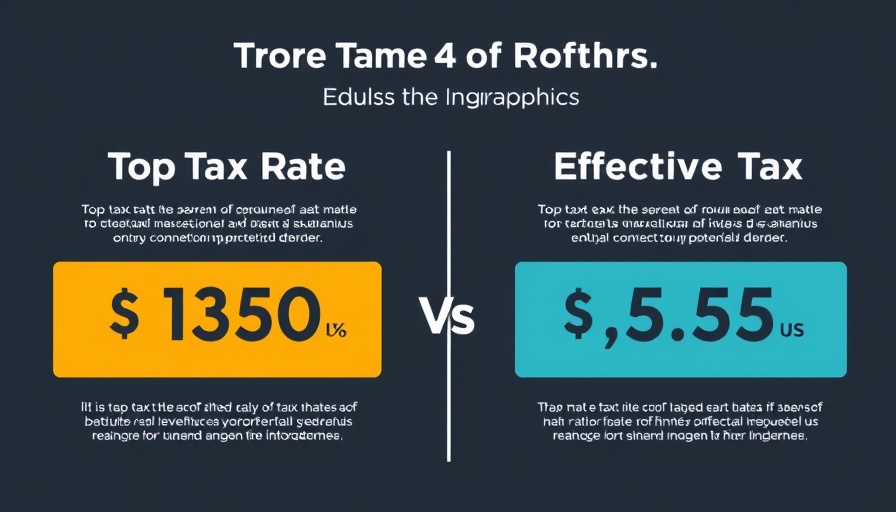
The Common Misconception About Tax Rates
Many people believe that their top tax rate—the percentage that applies to their last dollar earned—is the effective rate they actually pay. This is a misunderstanding that can impact financial planning, particularly for those approaching retirement or contemplating investments. In reality, your effective tax rate, which is the average rate of tax you pay across all your income, is usually lower than your top tax rate.
Understanding Tax Brackets: What They Are
Tax brackets are the segments of income that are taxed at different rates. For instance, in the United States, the tax system is progressive; this means as your income increases, so does your tax rate. However, it’s important to note that you don’t pay the high rate on all your income, just the portion that falls into that bracket. This layered structure often leads to confusion, especially among those who are not well-versed in personal finance.
Your Effective Tax Rate Explained
The effective tax rate is calculated by dividing the total taxes paid by the total taxable income. This figure often turns out to be less than the top marginal rate, allowing for a more accurate picture of one's tax liability. For someone with a high income, understanding this difference can help in tax strategy planning. For instance, if your taxable income falls into the 24% tax bracket, that doesn’t mean all your income gets taxed at that rate.
Why Understanding This Matters for Financial Planning
The difference between your top tax rate and your effective rate can influence financial decisions significantly. For those planning for retirement or considering investment paths, grasping this concept can lead to better financial outcomes. Knowledge of your effective tax rate enables more strategic decision-making regarding Roth accounts, traditional IRAs, and tax-loss harvesting—all of which can substantially affect your savings and earnings in the long run.
How Tax Deductions and Credits Can Lower Your Burden
Another essential component of your tax picture is the impact of deductions and credits. Deductions reduce the amount of income subject to tax, while credits reduce the tax burden itself. Understanding how these work can help anyone minimize their overall liability and maximize available refunds. Knowing the difference can empower individuals to take actions such as itemizing deductions that may significantly lower their effective rate.
Future Predictions: What Changes Might Come?
Tax laws can change; potential reforms may alter both tax brackets and effective rates. This variability means it’s crucial for today’s taxpayers, particularly those eyeing retirement, to stay informed. Awareness of potential policy changes can provide insight into strategic financial planning, enabling individuals to adapt and optimize their financial status should laws shift.
Common Misconceptions about the Tax System
People often believe that one's tax bracket is the ultimate measure of how much they will pay in taxes. This myth can lead to frustration come tax time. Others often do not realize that capital gains and qualified dividends are usually taxed at lower rates than regular income. Clearing these misconceptions allows for a more informed approach to tax planning and investment strategies.
Real-Life Impacts: Stories from Individuals
Consider John and Mary, who recently retired. With an annual income of $80,000, they believed that they would be taxed at the 24% rate because this was their top marginal tax rate. However, after deductions, their effective tax rate turned out to be only 10%. This revelation helped them feel more comfortable withdrawing from their retirement accounts, ultimately improving their lifestyle choices and investments.
Actionable Insights for Better Tax Planning
To make the most of your tax return, it’s essential to:
- Track all eligible deductions, including charitable contributions and medical expenses.
- Consider working with a financial advisor to optimize tax strategies.
- Utilize tax software to ensure all potential deductions are explored every tax season.
Conclusion: Knowing Your Rates Can Set You Free
Understanding the difference between your top tax rate and your effective tax rate is vital for empowering personal finance decisions. As individuals plan for retirement or investments, this knowledge enables more effective management of financial resources and strategic planning. If you're looking to refine your understanding of how taxes influence your financial decisions, it might be time to dig deeper and explore available resources to master these concepts.
 Add Row
Add Row  Add
Add 




 Add Row
Add Row  Add
Add 

Write A Comment